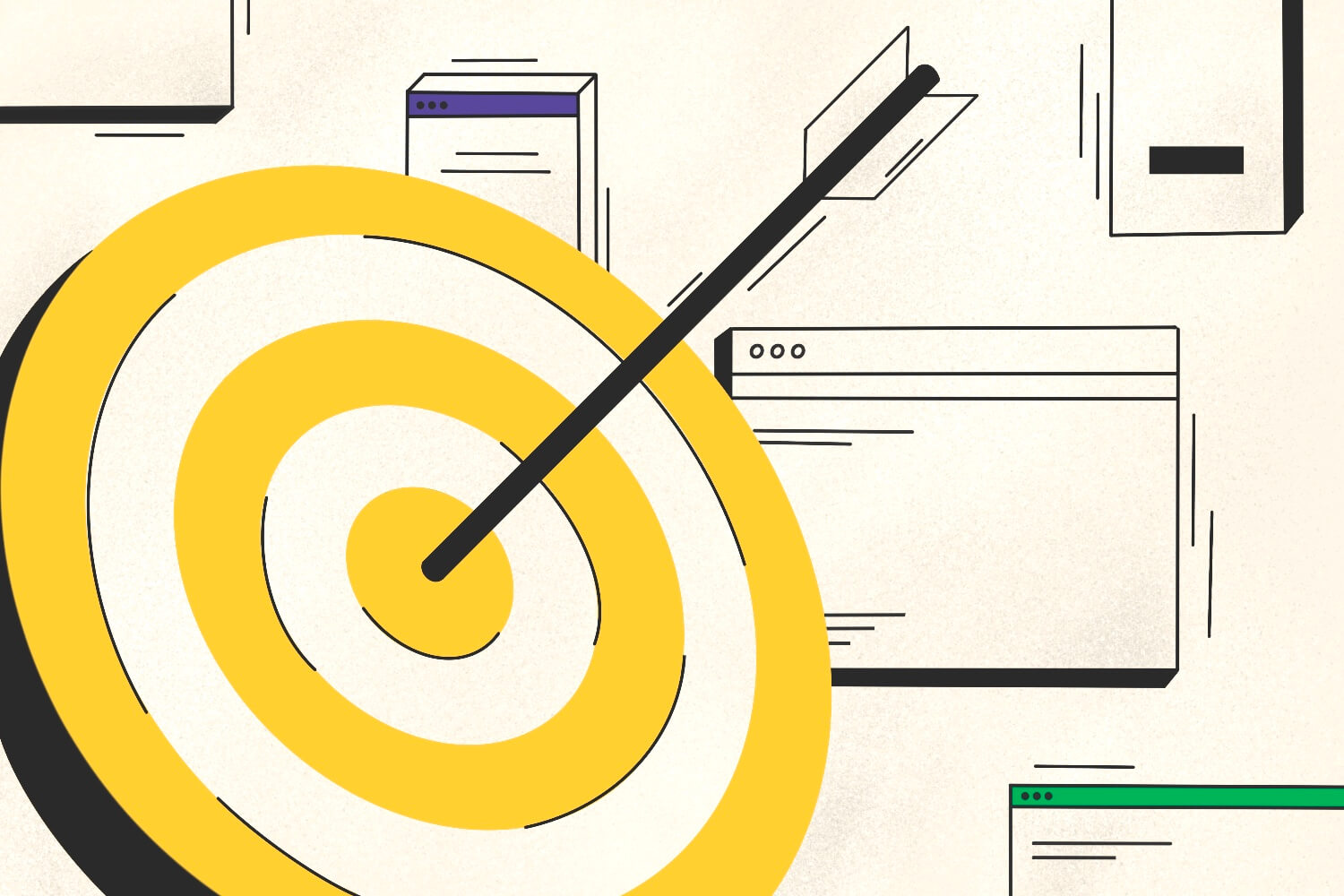Did you know that almost 98% of visitors that come to your website are not ready to buy?
Actually, only 2% of website visitors purchase on their first visit to an online store. Why is that so? Because people either don’t know how your product can help them or don’t want to buy the product yet.
Do you often wonder how to retarget prospects based on their activity with your website, product, or landing pages?
Website traffic custom audiences allow and help you to create a list of people who have visited your web page or taken particular actions, such as purchasing your product or inquiring about your services on your website. Then, you can target these audiences with highly relevant ad campaigns. Audience targeting helps you reach people based on their interests, like sports, lifestyle, and travel.
The ultimate goal is to engage the people who visited your website but haven’t taken action.
But how to do that, and which targeting option can help you reach people who’ve previously visited your website?
a) demographic targeting
b) remarketing
c) device targeting
d) interest category targeting
The answer is remarketing.
In this article, find out what remarketing is and how different targeting options can help you reach people who’ve previously visited your website.
What is the meaning of remarketing?
Remarketing is a way to re-engage people who previously interacted with your website or mobile app and one of the best ways to close a sale that didn’t happen. It is a powerful tool that allows advertisers to track visitors to websites or mobile applications.
This is how remarketing campaign works in an ideal case scenario:
For example, you have potential customers that visit your website but leave without checking out. Later they surf the internet and see your remarketing ads on other websites, which recaptures their interest and brings them back to your website. Then they find on your website what they are searching for, complete desired actions, and turn into happy customers.
If you once bought a particular product online and later saw similar ads for that product, then you experienced the remarketing strategy first hand, or even made a conversion.
Remarketing can be done in different ways, but we will focus on Google Ads remarketing and Facebook remarketing. How do you know which platform and type of remarketing campaign are best for you? Let’s find out.
How does remarketing work on Google?
Remarketing is an option provided by Google Ads advertising to show ads to people who have visited your website. It is used for showing ads to people who have already visited your website. Remarketing is especially useful for websites that expect a specific activity, i.e., conversion, from visitors. This can be a purchase in an online store, a booking accommodation, subscribing to a newsletter, inquiring about an offer, etc.
Humans are curious beings who often browse different internet websites, but when we need to take a specific action leading to a conversion, the vast majority give up.
That’s why we have to remarket. To remind your potential customers interested in an offer but have not yet decided to buy or send an inquiry to take action.
It is very likely that people will click on a remarketing ad rather than a “regular” ad and that people who click on the ad will make a specific conversion. This is because they have already established a relationship with your site. Running ads to these people serves to remind them that you have the solution they need.
Now let’s see the ways to target website visitors with Google Ads and Facebook Pixel.

How to set up retargeting campaigns in Google AdWords?
This is how Google defines remarketing:
Remarketing lets you show ads to people who’ve visited your website or used your mobile app. When people leave your website without buying anything, for example, remarketing helps you reconnect with them by showing relevant ads across their different devices.
Before setting up audiences for remarketing on the Google Ads platform, you must add the Google Ads remarketing code to your site.
Follow these steps to set up a retargeting campaign in Google AdWords successfully:
First, sign in to your AdWords account and open the ‘Shared Library’ option. Then click ‘Audiences’ and do ‘Set-up Remarketing’. Now click ‘View AdWords Tag for websites’ and select and copy the provided remarketing tag code for your website. The tag works for both mobile and desktop websites.
Place the tag code at the bottom of the website pages you want to use for your campaign. Then save and publish your page.
Use ‘Google Tag Assist’ to check if your tag is working correctly, click ‘Continue’, and then click ‘Return to Audiences’.
The tag will start collecting the website visitors’ cookies within a few days, and the ‘All Visitors’ list in your account will begin to fill up. Running your retargeting campaigns through Google, your ads will get the most exposure across the internet.
To show you how a typical Google AdWords retargeting ad looks like in practice, we took Spotify as an example.
Spotify uses traditional display remarketing and includes a promotion to reach people as they browse other websites. When they see the ad, people can easily click the CTA button and get a free trial of Spotify Premium. This ad aims at traditional Spotify users who have yet to upgrade to the premium version.
How to set up retargeting campaigns on Facebook?
Facebook advertising is aimed at anyone who wants to increase their visibility.
Facebook remarketing works similarly to Google Ads, but instead of running ads on Google search, partner sites, or YouTube, they run on Facebook or Instagram.
When starting with a Facebook retargeting campaign, you need to create a Facebook account for Business ads.
When you create a Facebook account for Business ads, the next step is to go to Facebook Ads Manager, choose the Audiences section, and select “Custom Audiences”. This will help you reach out to visitors with relevant ads who have previously visited your website or an app.
From the “Custom Audiences” list, choose the option “Website Traffic” as your marketing goal. Then create a list of people who have visited your website and select the audience you want to target your retargeting ads from the drop-down menu in the “Website Traffic” tab.
Facebook audience remarketing is also called “Custom Audience”. The concept is the same:
- Someone visits your site
- Facebook code adds a cookie that tracks them
- Your ads appear to them while they use Facebook or Instagram
After selecting the audience options, Facebook provides you the Facebook Pixel tracking code for the website to track your visitors. When targeting your audience and measuring performance, the Pixel is the most valuable Facebook tool to do it. It tracks website visitors from a page on your site to an ad inside your mobile app so you can later target them based on their online behavior.
Facebook retargeting helps you optimize ads based on the data that you gather from your campaigns, track conversions on Facebook ads, and create better ads in the future.
Bonus retargeting tips to get more customers
Don’t be intrusive to your customer
Don’t show ads only once or twice, but don’t be intrusive either. Limit the retargeted ads that customers see. Marketers typically recommend 17-20 retargeting ads per user per month. Before making the final click back to your website and converting, people have to see an ad several times.
Start retargeting with one retargeting platform
Start with one retargeting network, for example, Google Ads. This way, you can learn as much about it as possible before moving to another.
Write multiple ads to target different potential customers
People who look at your homepage will have less information than the person who left from the landing page. Write different ads for different people.
Don’t retarget customers for the same item
If you sold someone a mobile phone, show them headphones, phone cases, or some other gear in your next ad.
Track your ads’ data
This is a crucial component for any online marketing campaign to get the highest level of performance from your retargeting campaigns.
Ads are all about getting customers back to your site. Make them one to remember!
Want to start using retargeting on your website?
Retargeting is essential to your business because it allows attracting the most qualified customers.
If you want to drive conversions, you should focus on attracting new traffic, bringing previous visitors back to your site, and reminding them of your products and services. This way, people get more familiar with your brand and are more likely to choose you over your competitors.
Try not to have high expectations because most website traffic won’t convert on the first or second visit. People aren’t ready to buy your product or service after only one visit to your website because they don’t know who you are, what you offer, or how you could help them.
But with retargeting, you can get people to come back and purchase your product in the end.
Want to turn more ad clicks into conversions? We are the place where businesses come to grow. Talk to us and learn more about how you can start reaching previous site visitors and boosting conversions today.
If you have a (re)targeting option that works best for you, we would like to know. Contact us at hello@asynclabs.co.
